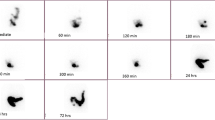Summary
The present study was prompted by the need for an accurate method by which the speed of propulsion of gastrointestinal contents could be assessed.
The transit time of a single injection of an indicator substance in a segment of human jejunum in vivo was determined with radio-Renografin-125I and phenolsulfonphthalein as markers. The markers were nonabsorbable and mixed satisfactorily with intestinal contents over a 25-cm. segment of jejunum.
The peak concentration time is proposed as a more representative and practical value of the transit time in the gastrointestinal system than the mean transit time. This opinion is based on (1) the dissimilarities between the cardiovascular and gastrointestinal systems—namely, the slow flow rate and the presence of considerable cephalad transport in the gastrointestinal tract; (2) statistical correlation between appearance time, peak concentration time, and mean transit time; and (3) the simplicity and speed of determination of the peak concentration time.
Similar content being viewed by others
References
Alvarez, W. C., andFreelander, B. L. The rate of progress of food residues through the bowel.J Amer Med Ass 83:576, 1924.
Mulinos, M. G. The value of selective drugs in the treatment of constipation.Rev Gastroenterol 2:292, 1935.
Hansky, J., andConnell, A. M. Measurement of gastrointestinal transit, using radioactive chromium.Gut 3:187, 1962.
Farrar, J. T., andBernstein, J. S. Recording of intraluminal gastrointestinal pressures by a radiotelemetering capsule.Gastroenterology 35:603, 1958.
Zierler, K. L. A simplified explanation of the theory of indicator-dilution for measurement of fluid flow and volume and other distributive phenomena.Bull Hopkins Hosp 103:199, 1958.
Meier, P., andZierler, K. L. On the theory of the indicator-dilution method for measurement of blood flow and volume.J Appl Physiol 6:731, 1954.
Dow, P. Estimations of cardiac output and central blood volume by dye dilution.Physiol Rev 36:77, 1956.
Dillard, R. L., Eastman, H., andFordtran, J. S. Volume-flow relationship during the transport of fluid through the human small intestine.Gastroenterology 49:58, 1965.
Barreiro, M. A., McKenna, R. D., andBeck, I. T. A simple device for timed sampling in physiological studies of human small bowelin vivo.Gastroint Endosc 13:28, 1967.
Abele, J. E. The physical background to freezing point osmometry and its medicalbiological applications.Amer J Med Electron 2:32, 1963.
Jacobson, E. D., Bondy, O. C., Broitman, S. A., andFordtran, J. S. Validity of polyethylene glycol in estimating intestinal water volume.Gastroenterology 44:761, 1963.
Hydén, S. A turbidimetric method for the determination of higher polyethylene glycols in biological materials.Ann Agric Coll Sweden 22:139, 1955.
Hogben, C. A. The alimentary tract.Ann Rev Physiol 22:381, 1960.
Reynell, P. C., andSpray, G. H. The simultaneous measurement of absorption and transit in the gastrointestinal tract of the rat.J Physiol (Lond.)131:452, 1956.
Cantor, M. O. Intestinal Intubation. Thomas, Springfield, Ill. 1949, p. 116.
Wood, E. H., andSwan, H. J. C. Definition of terms and symbols for the description of circulatory indicator-dilution curves.J Appl Physiol. 6:797, 1954 (7:ii, 1955).
Barreiro, M. A., McKenna, R. D., andBeck, I. T. The physiologic significance of intraluminal pressure changes in relation to propulsion and absorption in the human jejunum.Amer J Dig Dis 13:234, 1968.
Reynolds, O. An experimental investigation of the circumstances which determine whether the motion of water shall be direct or sinuous, and of the law of resistance in parallel channels.Philosoph Trans 174:935, 1883.
Burton, A. C. “Hemodynamics and Physics of the Circulation.” InPhysiology and Biophysics (ed. 19). Ruch, T. C., and Patton, H. D., Eds. Saunders, Philadelphia, 1965, p. 523.
Davenport, H. W. Physiology of the Digestive Tract (ed. 2). Yr. Bk. Pubs., Chicago, 1966, p. 66.
Posey, B. L., Jr., andBargen, J. A. Observations of normal and abnormal human intestinal motor function.Amer J Med Sci 221:10, 1951.
Author information
Authors and Affiliations
Additional information
Supported in part by Grant MA-1890 from the Medical Research Council of Canada, and by the Donner Canadian Foundation.
The authors thank Drs. J. Taylor and M. Stephens, Department of Mathematics, McGill University, and Dr. A. Oriol, Cardiology Division, McGill University Clinic, Royal Victoria Hospital, for their contribution in the development of the methods, and Miss D. Dannacker for her technical assistance.
The work reported here formed part of the M.Sc. thesis of M. A. Barreiro (McGill University, 1966).
Rights and permissions
About this article
Cite this article
Barreiro, M.A., McKenna, R.D. & Beck, I.T. Determination of transit time in the human jejunum by the single-injection indicator-dilution technic. Digest Dis Sci 13, 222–233 (1968). https://doi.org/10.1007/BF02236597
Issue Date:
DOI: https://doi.org/10.1007/BF02236597




